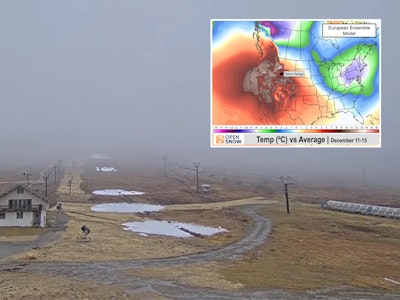Featured Image: Matt Power
La Niña conditions are most likely to emerge in November 2024 – January 2025 (59% chance), with a transition to ENSO-neutral most likely by March-May 2025 (61% chance). Climate Prediction Center: ENSO Diagnostic Discussion
La Niña outcomes are typically rare compared to El Niño, and they can bring copious amounts of snow the Pacific Northwest (PNW) and North Western Rocky Mountain regions of the U.S. Consider the winter of 1998/99. The legendary Mt. Baker Ski Area in Washington set the record for most snowfall at a ski resort in a single season with 1,140 inches (95 FEET) of snow. That winter was, you guessed it, a La Niña winter.
ENSO-neutral continued in November, with near-average sea surface temperatures (SSTs) observed across the central and eastern equatorial Pacific Ocean [Fig. 1]. Similar to the last couple of months, the latest weekly Niño indices ranged from +0.1°C (Niño-1+2) to -0.4°C (Niño-3; [Fig. 2]). Below-average subsurface ocean temperatures persisted [Fig. 3] across the east-central and eastern equatorial Pacific Ocean [Fig. 4]. Over the western and central equatorial Pacific, low-level wind anomalies were easterly and upper-level wind anomalies were westerly. Convection was suppressed over the Date Line and was enhanced over western Indonesia [Fig. 5]. The traditional and equatorial Southern Oscillation indices were positive. Collectively, the coupled ocean-atmosphere system reflected ENSO-neutral.
The dynamical models in the IRI plume continue to predict a weak and a short duration La Niña, as indicated by the Niño-3.4 index values less than -0.5°C [Fig. 6]. This prediction is also reflected in the latest North American Multi-Model Ensemble (NMME), which continues to predict slightly cooler SSTs and weak La Nina conditions. The forecast team leaned toward predicting an eventual onset of weak and short-lived La Nina conditions, based on the model guidance and current atmospheric anomalies. Weak La Niña conditions would be less likely to result in conventional winter impacts, though predictable signals could still influence the forecast guidance (e.g., CPC’s seasonal outlooks). In summary, La Niña conditions are most likely to emerge in November 2024 – January 2025 (59% chance), with a transition to ENSO-neutral most likely by March-May 2025 (61% chance; [Fig. 7]).
This discussion is a consolidated effort of the National Oceanic and Atmospheric Administration (NOAA), NOAA’s National Weather Service, and their funded institutions. Oceanic and atmospheric conditions are updated weekly on the Climate Prediction Center web site (El Niño/La Niña Current Conditions and Expert Discussions). Additional perspectives and analysis are also available in an ENSO blog. A probabilistic strength forecast is available here. The next ENSO Diagnostics Discussion is scheduled for 9 January 2025.
Climate Prediction Center
5830 University Research Court
College Park, Maryland 20740



![[GIVEAWAY] Win a Head-to-Toe Ski Setup from IFSA](https://www.datocms-assets.com/163516/1765920344-ifsa.jpg?w=200&h=200&fit=crop)


![[GIVEAWAY] Win a Legendary Ski Trip with Icelantic's Road to the Rocks](https://www.datocms-assets.com/163516/1765233064-r2r26_freeskier_leaderboard1.jpg?auto=format&w=400&h=300&fit=crop&crop=faces,entropy)




![[GIVEAWAY] Win a Head-to-Toe Ski Setup from IFSA](https://www.datocms-assets.com/163516/1765920344-ifsa.jpg?auto=format&w=400&h=300&fit=crop&crop=faces,entropy)


